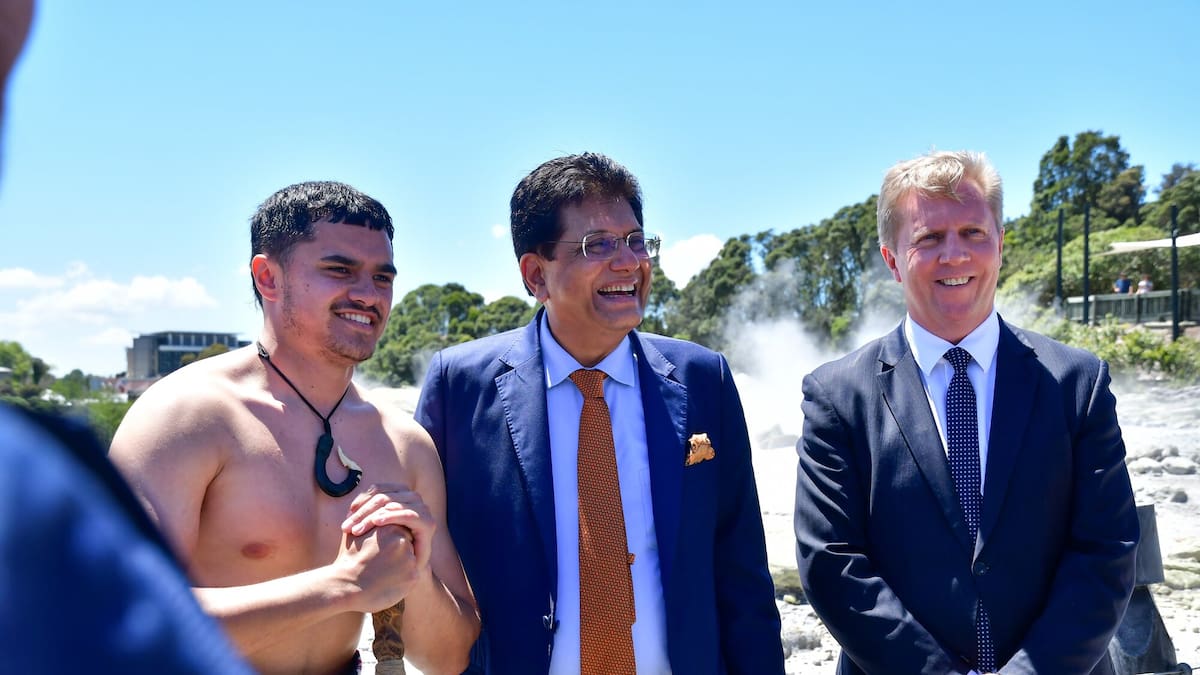None of that was on display during his New Zealand visit.
He won an audience over when he told a tale against himself recounting how as a tourist on his first visit to New Zealand nearly 20 years ago, with his wife and two kiddies, he notched up several speeding fines, which kept escalating after they were forwarded to India.
It was the last time he ever drove a car, he said jokingly, prompting Trade Minister Todd McClay to say “you can drive mine” in regard to Goyal’s visit to Rotorua.
In the international theatre – at the World Trade Organisation (WTO) or defending India against the onslaught of US President Donald Trump’s tariffs – he has nerves of steel.
But it is the connection he has forged with McClay at the WTO and G20, where there is commonality in keeping some vestige of the international trading system alive, which helps paper over bilateral niggles.
“We have developed a deep personal friendship over the last year and a half, where we respect each country’s sensitivities,” Goyal said.
The mutual bonhomie was obvious.
Goyal has been in New Zealand for several days as free trade talks between New Zealand and India continued into their fifth round.
Typically, nothing will be agreed until everything is agreed. But it is obvious both sides have made significant progress – notwithstanding each country’s respective sensitivities, including India’s concerns over New Zealand’s dairy trade.
Goyal was thronged when he came off the stage at the India-New Zealand Business Forum on Wednesday. New Zealand-based Indian business people had enthusiastically fanned hopes the free trade talks would be concluded this week – but that was always fanciful.
However, their optimism will be strengthened by Goyal’s later projection that New Zealand and India can increase their bilateral trade and boost investment flows tenfold.
India is New Zealand’s 12th-largest two-way trading partner, with total trade value reaching $3.14 billion in 2024.
“We are about US$1.2b–US$1.3b [$2.13b-$2.3b], in terms of bilateral trade. Personally, I don’t see why this can’t be 10 times what it is,” Goyal told a Rotorua business roundtable on Thursday.
“Our investments, mutually, have been very, very minuscule. I don’t see any reason why it can’t be 100 times in the next five years.”
Is Goyal over-egging the potential free trade agreement (FTA) prize?
Not necessarily so.
Go back 21 years to when visiting Chinese Commerce Minister Bo Xilai used the phrase “gold-medal winner” as an Olympic-themed metaphor to praise New Zealand’s decision to become the first country to recognise China as a market economy.
That led to China and New Zealand signing a Trade and Economic Co-operation Framework, the first formal step towards an FTA.
Bo was later ousted from power in a major political scandal and is currently serving a life sentence in prison for bribery, embezzlement and abuse of power.
But the growth trajectory in China-New Zealand bilateral trade over a 21-year period does show trade has increased 10 times, from about $3.4b in 2004 to over $38b in 2024.
China’s decision to wipe tariffs on New Zealand dairy exports to zero over a 20-year phase-out played a part.
Goyal projects a bilateral FTA with New Zealand will boost co-operation across trade, technology, education, defence, agriculture and food processing, benefiting farmers, fishermen and small businesses in both countries.
Given India’s galloping prowess on technology and the rapid digitisation of that country, there is an opportunity to collaborate in areas that could drive a productivity dividend for New Zealand businesses.
If talks are brought to a conclusion in the first quarter of 2026 – which appears necessary given that political attention will then become deflected by electoral timetables in both countries – the Prime Minister will have achieved his aim of achieving a bilateral deal during the coalition’s first term in power.
McClay highlights that negotiations have progressed faster than any previous New Zealand trade deal, with five rounds completed in just seven months.
He has been to India multiple times to meet with Goyal and heads off again next week to take part in a trade conference at the Indian minister’s invitation.
This week’s visit has been about getting the atmospherics right: demonstrating to Goyal that irrespective of the size differential (India is now on track to become the world’s third-largest economy), New Zealand does have plenty to offer.
Importantly, the 300,000-strong local Indian community are championing the deal, with business luminary Edwin Paul saying businesses from both sides should start preparing for the culmination of the free trade agreement.
“They should start playing out scenarios and initiate strategic partnerships in anticipation of the trade deal.”
During his journey to Rotorua, Goyal met with Air New Zealand chief executive Nikhil Ravishankar to talk about collaboration in aviation and tourism, with Goyal highlighting India’s rapidly growing aviation sector and the opportunities it offers for expanding air connectivity and passenger traffic between the two nations.
With Kiwi Campbell Wilson also chiefing Air India, the bilateral symbolism could not be more apt.
Catch up on the debates that dominated the week by signing up to our Opinion newsletter – a weekly round-up of our best commentary.

